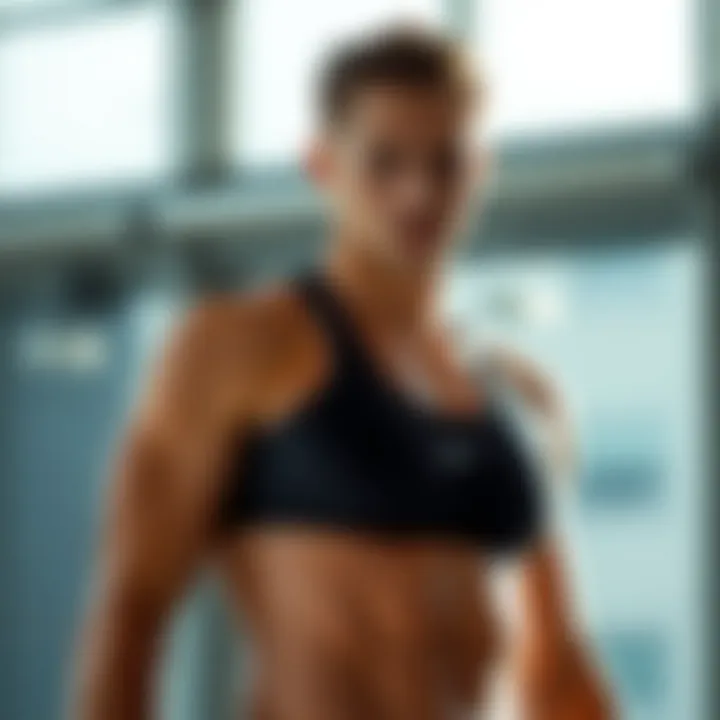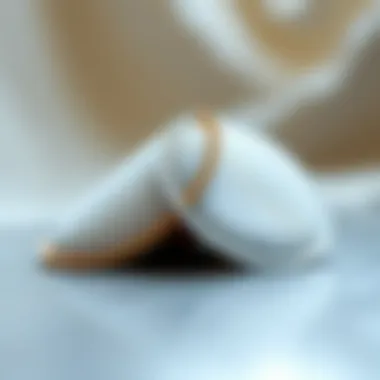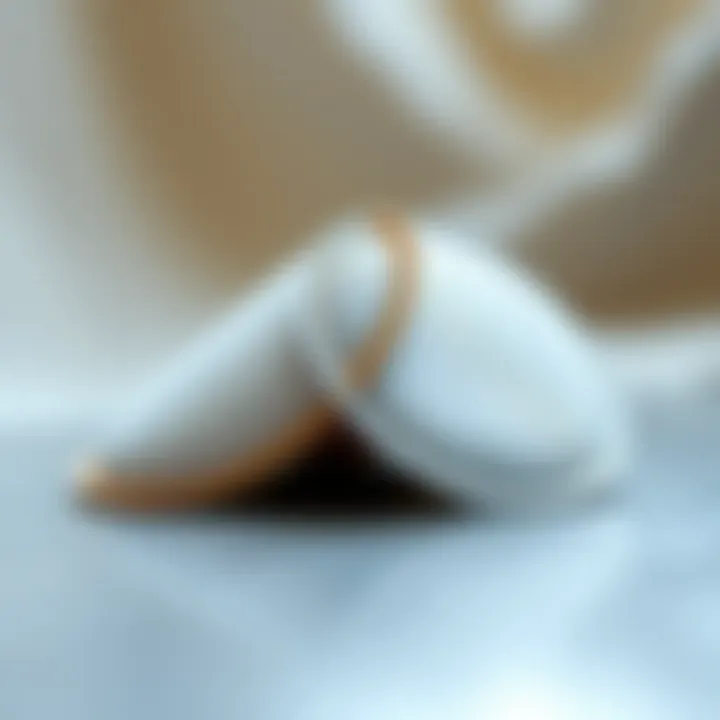The Ultimate Guide to Perspiration Pads for Comfort


Intro
As we navigate the ever-changing landscape of fashion, one element often goes unnoticed yet plays a crucial role in our overall comfort and confidence—perspiration pads. These innovative solutions have emerged from the shadows, gaining traction as an essential accessory for those who seek to meld style with practicality.
The modern consumer is increasingly aware of how their attire impacts personal comfort, particularly when it comes to managing sweat. With a plethora of choices available, from materials to designs, understanding the nuances of perspiration pads is vital for fashion designers, stylists, and retail workers alike. This guide aims to dissect every aspect of perspiration pads, providing a thorough exploration to navigate the intricacies involved.
By delving into current trends, practical advice, and the evolving technology behind sweat absorption, we set the stage for informed choices. Thus, let's take a closer look at the current trends that are influencing our approach to not just fashion, but how we enhance our daily experience through thoughtful garment choices.
Current Trends in Fashion
In the fashion industry, keeping a pulse on current trends is pivotal, especially when it relates to comfort-enhancing products like perspiration pads. As consumers demand more from their clothing and accessories, designers and brands must adapt.
Key Styles of the Season
This season, we witness a shift towards lightweight and breathable fabrics that not only elevate style but also complement perspiration management. Fabrics such as Tencel and modal offer soft textures without compromising on moisture-wicking capabilities, allowing perspiration pads to work effectively. Some notable trends include:
- Athleisure: The fusion of athletic wear and everyday fashion continues to dominate. Pieces like joggers and moisture-wicking tops are staple items that often incorporate perspiration pads seamlessly.
- Layering: Designers are now focusing on layered looks that provide versatility. Using perspiration pads ensures that even while dressed in multiple layers, one doesn't have to compromise on comfort.
- Sustainable fashion: There's an increasing interest in eco-friendly materials, which often dovetail with moisture control technology. Fabrics made from recycled plastics or organic cotton are on the rise.
Influential Designers and Their Impact
Some designers are carving new paths in this arena, blending sustainability with innovative designs.
For instance, brands like Reformation and Stella McCartney stand out for their commitment to eco-conscious choices. They not only highlight the importance of sustainability but also recognize the need for functional items like perspiration pads. Their collections reflect an understanding that the modern consumer seeks fashion that respects both style and the planet.
"Fashion is about dreaming and making other people dream." – Donatella Versace
This ethos promotes a broader acceptance of perspiration pads that cater to aesthetics and practicality without skimping on style.
Practical Fashion Advice
Tackling the question of perspiration pads extends beyond mere acknowledgment of their existence. Here we offer guidelines for choosing the right materials and building a wardrobe where comfort can harmonize with style.
Guidelines for Choosing the Right Fabrics
Selecting the appropriate fabrics is paramount for anyone looking to enhance their comfort level through apparel. Focus on:
- Moisture management: Fabrics like polyester blends and bamboo fibers excel at wicking away sweat, making them ideal companions for perspiration pads.
- Breathability: Look for materials that allow air circulation, such as cotton-knits or blends with key technological advancements that promote airflow.
- Durability: It’s important to assess the longevity of the fabric, ensuring it can withstand multiple washes without losing its effective properties.
Tips for Building a Versatile Wardrobe
Fashion flexibility is crucial. To build a wardrobe that allows for easy incorporation of perspiration pads, consider:
- Neutral colors: Opt for neutral shades that can be paired with various styles, ensuring that perspiration pads remain unnoticed.
- Mixing textures: Incorporate different fabric textures to enhance visual interest while still considering moisture control.
- Statement pieces: Invest in a few standout items that highlight your unique style but remain supportive of perspiration management.
By keeping these practical tips in mind, individuals can effortlessly enhance their wardrobe while maintaining comfort across different social settings. Maintaining a keen eye on trends and understanding practical applications helps shape informed decisions for both fashion professionals and everyday enthusiasts.
Prelude to Perspiration Pads
In the ever-evolving realm of fashion, perspiration pads have emerged as an unsung hero. These discreet accessories offer practical solutions to an age-old dilemma: how to manage sweat without compromising one’s style. The importance of perspiration pads lies not only in their ability to absorb moisture but also in their role in boosting confidence among individuals, particularly in professional and social environments where first impressions matter.
By integrating perspiration pads into daily attire, one can sidestep the embarrassment of sweat stains, which can undermine self-esteem and poise. Its relevance goes deeper than mere aesthetics; it is about personal comfort and the assurance that one can navigate through the day without undue worry. From board meetings to fashion runways, perspiraton pads provide an essential layer of protection.
Understanding Perspiration Pads
What exactly are perspiration pads? Essentially, they are absorbent materials designed to capture sweat, typically worn under clothing in areas prone to moisture, such as underarms and feet. These pads come in various shapes and sizes, tailored to fit different body parts and garments. Their main function is to minimize discomfort caused by moisture, thereby enhancing the overall wearing experience.
While perspiration pads are often associated with a stigma of embarrassment, they are, in fact, a clever and practical response to a common human experience. Most of us deal with perspiration regardless of the weather or occasion, making these pads not just useful but almost a necessity for many.
Historical Context of Sweat Management Solutions
Understanding the history of sweat management gives us insight into how far we’ve come and the innovations that have followed. Historically, people have employed various methods to tackle perspiration, from natural materials like cotton cloths to modern synthetic fabrics. The notion of managing sweat can be traced back centuries, with ancient civilizations utilizing everything from scented oils to specially designed garments to cope with heat and moisture.
In the 19th century, the advent of antiperspirants marked a pivotal moment. However, many individuals found these products ineffective or unsuitable due to skin sensitivities. This gap paved the way for the exploration of perspiration pads, providing a physical barrier against sweat rather than relying solely on chemical solutions. Today, with advancements in fabric technology, perspiration pads not only absorb moisture but also promise an improved fit and better adherence, catering to the modern consumer's demand for both function and fashion.
From the ancient concoctions to the high-tech solutions we have now, the evolution of sweat management strategies reflects a growing awareness of personal comfort, style, and practicality in everyday life. Understanding this history sheds light on why perspiration pads are not just a trend but a meaningful addition to the wardrobes of the conscious consumer.
Types of Perspiration Pads
Understanding the various types of perspiration pads is essential for anyone looking to enhance their wardrobe and comfort. Each type serves a distinct purpose and comes with its own set of characteristics that can cater to different needs and situations. In this section, we will delve into the main types of perspiration pads: underarm pads, dress shields, and foot pads. Each type offers unique benefits and considerations that can be pivotal in decision-making.
Underarm Pads
Underarm pads are arguably the most recognized type of perspiration pads. They help manage sweat in one of the most sensitive areas, allowing wearers to feel more comfortable and confident.
Material Choices
Material is a key aspect of underarm pads. Common materials include cotton, bamboo, and synthetic blends. Cotton is breathable and offers moisture-wicking properties. Its ability to absorb sweat while feeling soft against the skin makes it a favorite. Synthetic options, on the other hand, may provide better moisture management but often lack the breathable qualities of natural fabrics. Some users find synthetic pads irritating, while others appreciate their durability.


- Key Characteristics: Natural materials are more skin-friendly, while synthetics can offer better performance.
- Advantages/Disadvantages: Cotton may need more frequent changes, whereas synthetic pads can be more irritating if worn for extended periods.
Sizes and Shapes
The sizing and shape of underarm pads can greatly affect their effectiveness. Many brands offer various sizes to accommodate different body types and clothing styles. Some pads are contoured to fit snugly in the underarm area, while others are larger and more rectangular, catering to those who may sweat more heavily.
- Key Characteristics: Having the right size ensures maximum coverage, which is crucial for effectiveness.
- Advantages/Disadvantages: A well-sized pad can prevent leaks, but finding the right fit can require some trial and error.
Adhesive Properties
The adhesive strength of underarm pads is also significant. Some pads come with a stronger adhesive, ensuring they stay in place throughout the day. Others may use a less aggressive adhesive that is gentler on the skin but might require more frequent adjustments.
- Key Characteristics: Strong adhesives are ideal for high-activity users.
- Advantages/Disadvantages: A stronger adhesive may be harder to remove, potentially causing discomfort in sensitive skin areas.
Dress Shields
Dress shields are designed specifically for clothing to prevent visible sweat marks that can ruin an outfit.
Design Features
Dress shields tend to focus on aesthetics as much as functionality. Many have a more tailored shape, allowing them to blend seamlessly with clothing. They can be found in various colors to match the garment they are intended for, ensuring that they remain discreet.
- Key Characteristics: Their design allows them to be nearly invisible under clothing.
- Advantages/Disadvantages: While they provide excellent concealment, some users may require more frequent changing.
Applications in Fashion
Dress shields have crossed into the realm of fashion, with stylists using them for important events like photo shoots and red-carpet appearances. They can help maintain the integrity of garments that are made from delicate fabrics prone to absorbing sweat.
- Key Characteristics: Their use in high-fashion scenarios highlights their importance.
- Advantages/Disadvantages: They can add an extra layer to an outfit but may also limit the garment's breathability.
Adaptability
Many dress shields are designed to adapt to different types of clothing, including contours and styles. Some are designed to be cut down to size, making them versatile for a range of garments.
- Key Characteristics: This adaptability allows for custom sizing.
- Advantages/Disadvantages: However, customization may lead to uneven application or discomfort if not done properly.
Foot Pads
Foot pads tackle another critical area where sweat can cause discomfort or embarrassment.
Construction Materials
Foot pads are made from various materials, including gels and ultra-absorbent fabrics. These materials aim to provide cushioning while effectively absorbing moisture. Some pads are designed for specific shoe types, such as high heels or athletic shoes.
- Key Characteristics: Enhanced cushioning can help with foot fatigue.
- Advantages/Disadvantages: While they provide comfort, some materials may retain heat, leading to sweaty feet.
Usage Scenarios
Foot pads are beneficial in situations where one expects to be on their feet for long periods. Whether attending a wedding, working in retail, or enjoying a day out, foot pads can provide relief.
- Key Characteristics: They can help prevent blisters and keep feet dry.
- Advantages/Disadvantages: However, frequent use may lead to reliance, and overuse can result in foot irritation.
Benefits
The primary benefits of foot pads include enhanced comfort and better foot hygiene. They contribute to a more pleasant wearing experience, especially in warmer conditions or during physical activity.
- Key Characteristics: Improved foot health can increase overall well-being.
- Advantages/Disadvantages: However, they may need to be replaced frequently, leading to ongoing costs.
Benefits of Using Perspiration Pads
The concept of perspiration pads transcends mere convenience; it tackles real concerns that many individuals face daily. These pads are not just a fashion accessory but rather contribute significantly to overall comfort and personal confidence. By understanding the core benefits, one gains insight into their value in the realm of modern fashion.
Enhanced Comfort
The fundamental allure of perspiration pads lies in their capability to enhance comfort throughout the day. When you think about it, there's nothing worse than feeling sticky or damp under armpits or on the soles of your feet. Perspiration pads allow you to sidestep those uncomfortable moments that can bring even the most confident person down a peg.
Prevention of Skin Irritation
One major benefit that often gets overlooked is the prevention of skin irritation. Prolonged moisture can lead to skin discomfort, chafing, and even rashes. Perspiration pads act as a barrier between the skin and moisture, absorbing sweat before it has the chance to cause irritation. The right pad makes it possible to engage in all-day activities without worrying about post-sweat irritation. While it's essential to choose pads made from soft materials to maximize this benefit, those designed with breathable fabrics are particularly popular because they maintain airflow, preventing that dreaded clammy feeling.
All-Day Freshness
Moving onto another standout feature, all-day freshness is a game changer. These pads actively absorb sweat, resulting in a clean, dry feeling from morning until night. It’s almost magical not having to constantly think about those embarrassing sweat spots. The innovative materials used in contemporary perspiration pads are designed to wick moisture away effectively, making them a sought-after choice for those who find themselves on the go. The unique aspect of these products is their ability to keep you feeling fresh even in warm weather or during intense physical activity. The downside? Not every pad is created equal, so choosing the right one becomes paramount.
Confidence Boost
Beyond comfort, perspiration pads play a vital role in enhancing personal confidence. A feeling of dryness and cleanliness leads to a confident demeanor, and that’s no small feat in today’s world where appearances often matter.
Reducing Visible Sweat


A primary way these pads bolster confidence is through reducing visible sweat. No one wants to feel self-conscious about sweat stains affecting their outfit. The visibility of sweat can derail your mood or even affect social interactions. By disguising sweat before it becomes a noticeable issue, perspiration pads help keep potential embarrassment at bay. Saliently, this allows individuals to wear whatever clothing they prefer without fear of those tell-tale marks that can diminish poise.
Fashion Flexibility
Finally, the concept of fashion flexibility cannot be stressed enough. With perspiration pads, wearers find they can embrace a broader wardrobe without constraint. Whether it's a fitted dress or a tailored suit, the possibilities are endless when one knows that sweat won't dictate their outfit choice. The unique feature of perspiration pads is how they seamlessly blend function with style, enabling individuals to express their personality through fashion without the limitations posed by sweat. However, attention must be paid to the right choices of pads, as not all options fit perfectly with every outfit.
"Our clothing choices shouldn’t be limited by our biology, but enhanced by innovations like perspiration pads."
In summary, the benefits of using perspiration pads are multifaceted, ranging from enhanced comfort to a significant boost in confidence. By addressing skin irritation and promoting fashion flexibility, these pads empower individuals in their day-to-day lives, ensuring they can confidently face the world, no matter the circumstances.
Material Considerations
When choosing perspiration pads, the materials used can make all the difference between good and great. The choice of materials plays a significant role in how effective the pads are at moisture control, comfort, and even environmental impact. Understanding material considerations can help consumers select products that not only meet their personal comfort requirements but also align with their values regarding sustainability and health.
Natural vs. Synthetic Fabrics
Breathability
Breathability is a key factor when it comes to selecting perspiration pads. When a material is breathable, it allows air to circulate, which prevents moisture buildup and maintains skin comfort. Natural fabrics like cotton and bamboo often excel in this area. For instance, cotton can provide comfort and airflow, making it a popular choice.
On the flip side, synthetic fabrics like polyester, although less permeable, can still offer benefits due to their lightweight nature and durability. However, they may trap heat, leading to discomfort. A unique feature of breathable materials is their ability to reduce the risk of skin irritation, a common concern for those using perspiration pads regularly.
- Advantages: Comfortable wear, reduces irritation, and maintains dryness.
- Disadvantages: Some may not absorb moisture as well as synthetic options.
Moisture-Wicking Properties
Moisture-wicking properties are essential for ensuring that perspiration is drawn away from the skin and evaporated quickly. Fabrics designed for wicking, such as those made from nylon or specialized polyester blends, are engineered to combat moisture accumulation effectively. These materials draw sweat away from the body to the surface of the pad, where it can dry more rapidly.
Synthetic options tend to be strong in this regard. For example, many activewear brands rely on moisture-wicking fabrics to keep athletes dry during intense workouts. Additionally, these properties can help maintain a fresher feel throughout the day, making them a sound choice for perspiration pads. Yet, they sometimes can feel sticky against the skin if moisture is not evaporated quickly enough.
- Advantages: Keeps skin dry, improves comfort throughout the day.
- Disadvantages: Can potentially lead to a clammy feeling if moisture wicking isn't effective.
Biodegradable Options
Today, sustainability is at the forefront of many consumers' minds. Many brands are starting to offer biodegradable perspiration pads that break down naturally, reducing waste. These options often utilize materials derived from natural sources like cornstarch or plant fibers.
Environmental Impact
The environmental impact of biodegradable options is notable. As awareness grows surrounding the hazards of plastic waste, products that naturally decompose are gaining traction. For designers and retailers, offering biodegradable perspiration pads can appeal to a conscientious customer base, helping to reduce the overall ecological footprint.
- Advantages: Reduced landfill contribution, lower carbon footprint.
- Disadvantages: May not always perform as well in moisture absorption compared to conventional materials.
Sustainable Fashion Choices
Sustainable fashion choices are tied closely to the materials used in perspiration pads. When designers select eco-friendly resources, they contribute to promoting a positive environmental narrative within the fashion industry. Additionally, many consumers now prioritize brands that take a stance on sustainability. This shift can lead to greater loyalty and preference for brands that produce eco-friendly products.
- Advantages: Aligns with consumer values, promotes ethical production.
- Disadvantages: Typically, pricing might be higher for consumers, limiting accessibility.
In summary, material considerations are not just about comfort and practicality; they encompass significant environmental implications that resonate with contemporary consumer values. Choosing wisely can make a difference, both personally and globally.
Insights into Usage
Understanding how to effectively use perspiration pads is crucial for maximizing their benefits. These pads are designed not only for comfort but also to ensure that users can go about their daily routines without worry about excess moisture. Grasping the right techniques for application and maintenance can greatly enhance the overall experience.
How to Apply Perspiration Pads
Applying perspiration pads correctly can seem simple, but it involves some specific steps that can make a world of difference in comfort and effectiveness.
Preparation Steps
Before applying perspiration pads, it is essential to prepare the skin properly. Cleansing the area where the pad will be placed is fundamental. This helps in achieving a good adhesive bond and ensures that any oils or residues don’t interfere with the pad's functionality. It’s also a good idea to allow the skin to dry completely after washing. Using a soft towel, pat the area dry instead of rubbing, which can irritate sensitive skin.
"Preparation isn’t just a step; it’s the foundation for effective perspiration management."
A key characteristic of these preparation steps is their simplicity; they require minimal time but yield significant benefits. Applying pads on clean, dry skin can lead to longer-lasting adhesion and improve comfort, making this an easy but crucial choice in the utilization of perspiration pads. However, a disadvantage might arise for those rushing, as skipping these preparatory measures could lead to a poor experience.
Placement Techniques
Knowing where to put perspiration pads can influence their effectiveness drastically. They are typically applied to areas where sweat is most prone to occur, like underarms or foot beds. It’s important to ensure that the pad lies flat, without creases, to avoid bunching up under clothing.
The most beneficial characteristic of these placement techniques is that they can vary based on individual anatomy and the specific pad style, offering flexibility based on user needs. Some might find that placing the pad slightly higher or lower offers better coverage, depending on the situation. However, improper placement can lead to discomfort or even reduced effectiveness, so it's essential to take a moment to adjust for the best fit.
Timing Considerations
Timing is another critical factor in the overall effectiveness of perspiration pads. Ideally, pads should be applied before heading out for the day. It is common for individuals to underestimate how quickly sweat can accumulate, especially in certain climates or during specific activities like workouts or social events.
The significant feature here is simply understanding one's own body and habits. If a user knows they sweat more during specific times, they should consider using the pads accordingly. One advantage is that by using the pads in anticipation of high-sweat situations, users can enjoy their day without worry. However, a downside might be the risk of forgetting to replace pads in prolonged scenarios, leading to potentially ineffective products if not checked regularly.


Longevity and Maintenance
Proper upkeep of perspiration pads contributes significantly to their functionality and cost-effectiveness in the long run.
Product Lifespan
The lifespan of perspiration pads varies by material and use. Some pads are meant for single-use, while others can withstand multiple wearings. Understanding the indicators for replacement is essential; if the pad feels damp or loses its adhesive qualities, it’s time to swap it out.
The benefit here is straightforward: knowing when to replace pads prevents discomfort and poor performance while providing peace of mind about hygiene factors. Yet, users should be cautious about overestimating the lifespan— too much usage can lead to skin irritations or other negative reactions.
Disposal Methods
How to dispose of used perspiration pads is another consideration that can impact sustainability efforts. Most pads are made from materials that can be disposed of in regular waste, but some may offer biodegradable alternatives.
The crucial aspect of responsible disposal routes back to fostering environmental awareness. Employing biodegradable pads is a beneficial choice in reducing waste and aligning with sustainable practices. Nevertheless, users should still be mindful of local disposal regulations to avoid negative impacts, especially if the pads don’t break down easily in certain environments.
By addressing these elements of usage, individuals can enhance their experience with perspiration pads, ensuring they meet personal and environmental standards while effectively managing suede and comfort.
Addressing Common Misconceptions
When diving into the world of perspiration pads, it's crucial to address some common misconceptions that might cloud the judgement of potential users. These beliefs can sometimes be rooted in outdated information or simple misunderstandings. By clarifying these points, we can empower consumers to make informed decisions that enhance their comfort and confidence.
Effectiveness During High Temperatures
One frequent assumption is that perspiration pads lose their effectiveness when subjected to high temperatures. It is a myth that can lead to unnecessary discomfort or reluctance to use these products during warmer months. In actuality, many modern perspiration pads are designed specifically to perform well under heat. Their construction often includes materials that not only absorb moisture but also allow for breathability.
Using perspiration pads during hot periods can help maintain a dry underarm area, reducing the risk of odor and skin irritation. Here is what you need to consider:
- Material Performance: Many brands incorporate advanced moisture-wicking technologies that respond well to increased sweat production.
- Adhesive Quality: A well-designed adhesive can keep pads securely in place, even in heat, which helps in improving confidence when wearing clothes.
- Comfort: Lightweight options exist that won’t weigh down even a light summer outfit.
It's essential for users to choose pads that suit their needs, as not all pads will perform equally in high temps. Researching and options can make a difference! Remember, just because some may have had a less-than-stellar experience doesn’t mean that all products fall short.
Skin Sensitivities and Reactions
Another misconception is that perspiration pads are only suitable for those with normal skin and can cause irritation for those with sensitive skin. This can discourage many potential users from exploring these solutions further. While it is true that some skin types may react poorly to certain materials, there are variations in product offerings that cater to sensitive skin.
- Hypoallergenic Materials: Many products on the market now utilize hypoallergenic, skin-friendly materials. These are designed to minimize any risk of irritation and provide a more gentle experience.
- Patch Testing: If there's concern about sensitivity, users can perform a patch test on a small skin area before committing to use a new product. This step can reveal any adverse reactions without full commitment.
- Read Reviews: Seeking out user experiences, particularly from those with similar skin issues, can offer valuable insights into product integrity and performance.
Perspiration pads are not one-size-fits-all, but with a bit of research, users can find options that align with their personal skin health needs. It's all in the approach; users should remember to consult product descriptions and customer feedback to discover what works best for them.
Being properly informed about perspiration pads often leads to a more comfortable experience during those difficult moments, regardless of temperature or skin sensitivity.
Understanding these common misconceptions isn't just about clearing the air—it's about enhancing the overall experience of using perspiration pads. This leads to greater acceptance and, ultimately, increased comfort in various social and professional situations.
Consumer Choices and Market Trends
In today’s fast-paced world, where impression is everything and sweat can be a foe, understanding consumer choices and market trends regarding perspiration pads is vital. Choosing the right perspiration pad isn't just about comfort; it's also about ensuring that the product aligns with personal values, preferences, and fashion needs. Buyers are becoming increasingly aware of how products affect their daily lives and the environment, leading them to scrutinize their choices closely.
Popular Brands and Products
When it comes to perspiration pads, there are several well-known brands that have established themselves as leaders in the market. These brands don't just focus on functionality but also excel in quality and innovation. Some popular brands include:
- Nivea – Known for skin care, they have ventured into sweat management with effective and skin-friendly options.
- Thinx – This brand has captivated the audience with innovative designs that blend well with modern attire, especially in women's wear.
- Secret – A long-standing player in the market, continuously evolving their products to fit various lifestyles.
- Dab Dry – Specializing in foot pads, they cater to active people needing reliability in their footwear.
Understanding these brands can help consumers navigate their options. It is beneficial to read reviews, ask peers, or search online platforms like reddit, to collect insights and experiences from other users.
Innovations in Sweat Control Technology
As consumer demands evolve, so does the technology behind perspiration pads. Innovations have come a long way in ensuring that users experience maximum comfort while maintaining dryness and effectiveness. For instance, moisture-wicking fabrics are no longer a novelty but a standard feature in many products, moving sweat away from the skin and allowing for comfortable wear throughout the day.
- Nanotechnology – This advanced tech is starting to find its way into perspiration pads, allowing for the creation of ultra-thin pads that are highly absorbent yet barely noticeable under clothing.
- Antimicrobial Treatments – Many brands are infusing their pads with substances that counteract odor-causing bacteria. This feature ensures that the user not only stays dry but also fresh.
- Smart Technology – There are even discussions in the market about integrating biosensors in pads to monitor sweat levels and provide data to wearers on their hydration and activity levels.
“The fusion of fashion with technology is reshaping our experience with perspiration pads, making them more than just functional items.”
Keeping an eye on these trends can empower fashion designers, stylists, and retail workers to suggest the best products to their clients, enhancing their offerings with the latest innovations. Understanding what consumers are looking for and how technology meets those needs is crucial for staying ahead in the market.
Finale
The exploration of perspiration pads throughout this guide underscores their growing significance in the realm of modern fashion. These products serve a vital purpose, not just for personal comfort but for maintaining one's confidence in a variety of social and professional settings. Perspiration pads are more than mere protectors against sweat; they are an integral part of today’s wardrobe essentials that cater to both functionality and style.
In an era marked by increasing awareness about personal hygiene and appearance, the role of perspiration pads has been catapulted to the forefront. As fashion designers and stylists continually seek innovative ways to marry style with substance, perspiration pads offer a unique solution to manage sweat discreetly. This fusion of practicality and aesthetic appeal speaks to the evolving landscape of fashion, where garments are designed not only to dazzle but also to offer comfort in diverse climates and conditions.
The Role of Perspiration Pads in Modern Fashion
Perspiration pads have transitioned from being a niche product to becoming a staple in many wardrobes. For fashion enthusiasts, these pads represent an advancement in sweat management solutions that prioritize both utility and elegance. They are now crafted from a variety of materials, ranging from premium cotton to advanced synthetic fabrics that maximize breathability and moisture-wicking capabilities.
When selecting perspiration pads, one must consider several elements:
- Design and Fit: The latest trends emphasize slim profiles that fit seamlessly under clothing without adding bulk.
- Variety of Options: From underarm pads to more specialized dress shields, the choices accommodate different body types and clothing styles, thus enhancing overall fashion flexibility.
- User Experience: Feedback from consumers highlights the importance of adhesive properties and material comfort, which significantly contributes to the effectiveness of these pads.
"Perspiration pads are a silent ally in the quest for confidence, allowing individuals to focus on what truly matters rather than worrying about sweat stains."
Knowledge of these factors can empower fashion designers and retail workers to better guide their customers in making informed choices. Enhanced awareness around perspiration pads reflects broader trends in sustainable fashion, too. As consumers lean towards eco-friendly materials, brands manufacturing biodegradable pads are gaining traction, complementing the move towards more environmentally conscious fashion practices.
In essence, perspiration pads not only address practical issues related to perspiration but also enrich the modern fashion narrative by offering solutions that align with consumer desires for both style and comfort. As we look ahead, the integration of innovation in the design and use of perspiration pads will likely remain a focal point for those in fashion and beyond.













